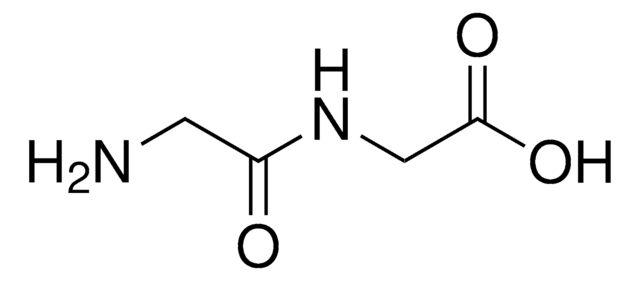G4505
Guanidine hydrochloride
≥99% (titration), organic base and chaeotropic agent
동의어(들):
Guanidium Chloride, Aminoformamidine hydrochloride, Aminomethanamidine hydrochloride, Guanidinium chloride
About This Item
추천 제품
생물학적 소스
synthetic (organic)
Quality Level
분석
≥99% (titration)
형태
crystalline powder
기술
RNA extraction: suitable
불순물
≤0.3% water (Karl Fischer)
색상
white
pH
(25 °C, 4.6 - 6 at 573 g/L)
mp
180-185 °C (lit.)
solubility
H2O: 6 M
density
1.3 g/cm3 (lit.)
흡수
≤0.10 at 260 nm in H2O at 6 M
SMILES string
Cl[H].NC(N)=N
InChI
1S/CH5N3.ClH/c2-1(3)4;/h(H5,2,3,4);1H
InChI key
PJJJBBJSCAKJQF-UHFFFAOYSA-N
유전자 정보
human ... KCNA1(3736) , KCNA10(3744) , KCNA2(3737) , KCNA3(3738) , KCNA4(3739) , KCNA5(3741) , KCNA6(3742) , KCNA7(3743) , KCNB1(3745) , KCNB2(9312) , KCNC1(3746) , KCNC2(3747) , KCNC3(3748) , KCNC4(3749) , KCND1(3750) , KCND2(3751) , KCND3(3752) , KCNF1(3754) , KCNG1(3755) , KCNG2(26251) , KCNG3(170850) , KCNG4(93107) , KCNH1(3756) , KCNH2(3757) , KCNH3(23416) , KCNH4(23415) , KCNH5(27133) , KCNH6(81033) , KCNH7(90134) , KCNH8(131096) , KCNQ1(3784) , KCNQ2(3785) , KCNQ3(3786) , KCNQ4(9132) , KCNQ5(56479) , KCNS1(3787) , KCNS2(3788) , KCNS3(3790) , KCNV1(27012) , KCNV2(169522)
유사한 제품을 찾으십니까? 방문 제품 비교 안내
일반 설명
애플리케이션
- to perform absolute quantitation of amyloid-beta (Aß) isoforms in plasma
- in protein carbonylation assay
- for the quantification of glycosaminoglycans (GAG)
- for denaturation of cow′s milk allergens
- as a control in antiviral screening tests with coxsackievirus B3 (CVB3)
- in RNA isolation to dissociate nucleoproteins and inhibit RNase
생화학적/생리학적 작용
특징 및 장점
- Suitable for Biochemical and Cell Biology research
- Ideal for RNA extraction
- High purity product for research applications
포장
Each kit contains 3 x 100G samples, each sample from a uniquely manufactured lot.
주의사항
제조 메모
The maximum solubility of guanidine hydrochloride in water at room temperature is approximately 6M.
기타 정보
법적 정보
신호어
Warning
유해 및 위험 성명서
Hazard Classifications
Acute Tox. 4 Inhalation - Acute Tox. 4 Oral - Eye Irrit. 2 - Skin Irrit. 2
Storage Class Code
11 - Combustible Solids
WGK
WGK 1
Flash Point (°F)
Not applicable
Flash Point (°C)
Not applicable
개인 보호 장비
dust mask type N95 (US), Eyeshields, Faceshields, Gloves
시험 성적서(COA)
제품의 로트/배치 번호를 입력하여 시험 성적서(COA)을 검색하십시오. 로트 및 배치 번호는 제품 라벨에 있는 ‘로트’ 또는 ‘배치’라는 용어 뒤에서 찾을 수 있습니다.
이미 열람한 고객
자사의 과학자팀은 생명 과학, 재료 과학, 화학 합성, 크로마토그래피, 분석 및 기타 많은 영역을 포함한 모든 과학 분야에 경험이 있습니다..
고객지원팀으로 연락바랍니다.






